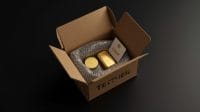
Crypto Copy-Paste Scams: Clipboard Hijackers
One of the simplest but most dangerous ways criminals steal crypto is through copy-paste scams. Also known as clipboard hijacker scams, this trick works by
FREE fully insured shipping on all orders.
An assay is the analysis used to test the purity and composition of a precious metal. In gold and silver, the assay ensures that coins and bars meet the mint’s stated standards. For example, if a mint claims its coin is 99.9% pure gold, the assay confirms this before the coin is released.
Historically, assaying was common when gold and silver circulated as currency. While that era has passed, assays remain essential for today’s collectors and investors to verify purity, protect value, and maintain trust.
Assayers take a sample of the metal—either shavings or molten material—before testing it through one of several methods:
Each method ensures that the final product meets claimed purity standards.
For investors and collectors, assays provide confidence that gold, silver, platinum, or palladium products are legitimate. They protect buyers from fraud and give sellers proof of purity when liquidating metals.
Most precious metals are sold with assay documentation. Common forms include:
Both offer traceability, authenticity, and assurance of purity.
A certificate of authenticity (COA) is another safeguard. Unlike an assay, it does not test purity. Instead, it verifies origin and authenticity, often with details such as:
COAs are most often included with commemorative coins, special releases, or limited editions. Bars rarely come with them unless issued in unique circumstances.
Veldt proudly serves customers across the United States with FREE insured nationwide shipping. We also welcome local clients at our San Diego office. If you’re nearby, you can meet with us in person to discuss your gold and silver investment strategy, pick up an order, or securely buy and sell precious metals for crypto.
Make an appointment to buy or sell gold and silver for crypto with us in Downtown San Diego.

One of the simplest but most dangerous ways criminals steal crypto is through copy-paste scams. Also known as clipboard hijacker scams, this trick works by

Disclaimer: This article is for educational purposes only. It is not tax advice. Always consult a licensed tax professional for guidance on your specific situation.

Buying gold and silver is a time-tested way to protect wealth, but scams are just as old as the metals themselves. Whether you are stacking

Precious metals are high-value items that attract theft if mishandled during transit. Whether you are buying from a dealer or selling to one, using secure
|
Gold: 4,332.40 | Silver: 66.04 | Platinum: 1,969.19 | Palladium: 1,749.23 |